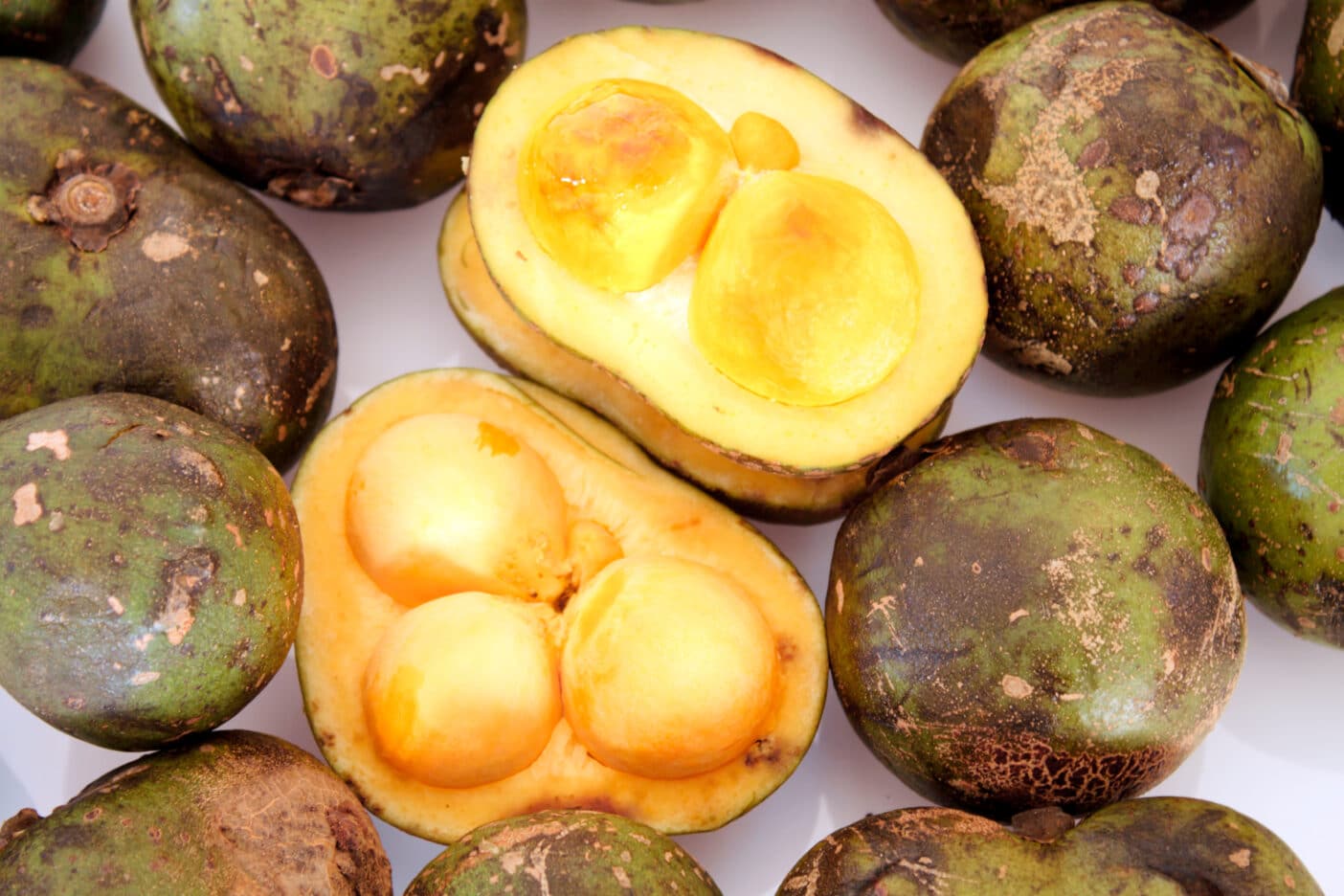Pequi oil

The pequi oil tree is native to the Cerrado, the Brazilian savanna. There are about 16 species, of which Caryocar Brasiliense is the most common.
The deciduous tree grows wild throughout midwestern Brazil. It reaches a height of about 12 meters.
Its drupes have yellowish, fibrous oily flesh and a hard pericarp.
The reddish-brown fruit usually contains two kidney-shaped stone seeds, the seed kernels of which have a good flavor.
Locals use the leaves for medicinal extracts and the fruit for culinary purposes. After boiling for an hour, the fruit can be eaten as a vegetable. From the fruits that cannot be sold fresh, they make fruit jams and extract oil.
This has anti-inflammatory properties and is used in folk medicine for liver inflammation or respiratory diseases and to protect against eye diseases.
The peel is rich in tannin and is used to make ink and dyes. Bark helps against athlete’s foot. The hard, robust wood is suitable for shipbuilding.
Pequi oil is extracted from the pulp and seeds and is locally called “gold of the Cerrado”. This is true because the pequi oil or souari nut provides a unique combination of biochemical compounds of proven efficacy and remarkable skin and hair care activity.
Extraction
In the traditional method, the fruit pulp is boiled over low heat and stirred until the oil settles to the surface and can be skimmed off. The oil is then filtered.
36 fruits yield about 2.4 liters of oil.
One tree bears about 350 fruits. However, not every year
One fruit weighs about 280 g, consists of 23% pulp, 6% seeds and has a fat content of 51-62%.
A tree can yield 38 kg of fruit pulp oil and up to 9 kg of seed oil in a year.
When solvents are used, the pulp must be dried beforehand. The oil and carotenoid content depend on the drying process and solvent.
Mechanical cold pressing is ideal.
Valuable ingredients
Pequi oil is mainly characterized by carotenoids and fatty acids, including omega fatty acids.
In addition, there are vitamin C, B vitamins, as well as zinc, calcium, and potassium.
Bioactive substances in pequi oil:
α-, β-carotene: support the cornification process, promote skin renewal, antioxidant;
Lutein, zeaxanthin: improve skin hydration, elasticity, anti-inflammatory;
Riboflavin: supports skin healing, for healthy skin and mucous membranes, anti-chapped skin, anti-redness;
Squalane: skin related fat, occurs in sebaceous gland secretions, softens the skin, and is suitable for dry skin care.
Fatty acids:
Fruit pulp oil: 36 – 66%.
Seed oil: 14 – 48
The fatty acid composition in pulp and kernel is similar, but the pulp oil has a higher content of carotenoids: 246µg/g
The ratio of saturated to unsaturated fatty acids is 42/58 with the following proportions:
Oleic acid (Omega 9): 51-60%.
palmitic acid: 36-41
Linoleic acid (Omega 6): 0,8-3%
Palmitoleic acid: 0.8-1.2%
α-linolenic acid (Omega 3): 0.2 -0.4%
Arachidic acid: 0.1 – 0.4%
Triglyceride composition varies from species to species.
Especially in the fruit pulp oil:
POP (1,3-dipalmitoyl-2-oleyl-glycerol).
POO (1,2-dioleyl-3-palmitoyl-glycerol)
POS (palmitoyl-oleyl-stearyl-glycerol)
The fruity fragrance results from the fruit esters, especially ethyl hexanoate with over 50%.
Use in medicine and food
The inner mesocarp contains 36-66% oil in dry matter and is traditionally used for food, food industry, oleochemistry, medicinal and cosmetic purposes.
In food production, the oil is used for cold dishes, ice cream and as an aromatic gourmet oil.
The triglycerols POO and POP make the oil interesting for the cosmetic and food industry.
Through physical, enzymatic or chemical modification or transesterification, the oil can be used as a cocoa butter substitute and as a zero trans fat product.
With its high palmitic acid content, pequi oil is suitable for margarine.
Several applications of the folk medicine could be confirmed scientifically in the meantime.
For example, in vivo studies confirm the liver-protective effect of cold-pressed pequi oil, which is due to its antioxidant and anti-inflammatory properties.
It can slow down arteriosclerosis in its early stages.
The high content of monounsaturated fatty acids (oleic acid) and carotenoids may reduce the risk of heart disease.
Preventive efficacy against age-related anemia has been demonstrated in mice.
Pequi oil is a vegan alternative to krill oil because of its omega fatty acid content.
Like the latter, pequi oil contributes to normal blood cholesterol and triglyceride levels, normalizes blood pressure, boosts brain function, supports vision and protects against sun damage and wrinkling.
A 2009 study showed that pequi oil can alter the ratio of triglycerides to cholesterol in the blood as well as reduce exercise-related inflammation and lower blood pressure. (Pequi oil fruit (Caryocar brasiliense Camb.) pupl oil reduces exercise-induced inflammatory markers and blood pressure). Subjects took 400 mg pequi oil capsules for 14 days.
Pequi oil in cosmetics
Due to its components and their special combination with antioxidant and moisturizing effects, pequi fruit is suitable for use in cosmetics.
The high content of flavonoids and fatty acids makes the pequi oil a precious care and anti-aging oil and a unique care ingredient for the hair.
The fatty acid with the highest percentage in the fatty acid profile, palmitic acid, is recommended for skin care as a component of the skin barrier and hydro-lipid film.
Omega-9 fatty acid has a refatting effect and is ideal for dry skin.
The effects of pequi oil on the hydration of the stratum corneum and to strengthen the barrier function have been proven.
In a clinical study, a single application of a formulation containing pequi oil to the forearm showed a significant and sustained increase in hydration and a reduction in transepidermal water loss. (Moisturizing effect of a cosmetic formulation containing pequi Oil /Caryocar Brasiliense from the Brazilian biome, 2014).
Due to its high viscosity, pequi oil is ideal for creams, lotions, shampoos.
It nourishes dry, brittle, mature skin, making it soft and supple.
It is suitable for skin care, whether facial care, cleanser, body cream, baby care, massage cream as well as sunscreen, after-sun care and is also indicated for rich bath and shower products.
Another important property for cosmetics is film formation. Pequi oil forms a protective, stabilizing film on skin, hair, nails, improves the adhesion of sunscreen, nail polish, mascara, hair styling, lip gloss. Lipstick.
Thanks to this property, it is ideal for use in hair care, whether shampoos, conditioners, styling products, hair masks, gels. It defines and stabilizes hair curls and prevents frizz, making it perfect for the care of wavy/curly hair.
With the floral fruity citrus note, it gives the formulation a pleasant scent and can mask the smell of other components.
Disadvantages
There are opportunities and risks in the increasing demand.
In sustainable use, it is ideal to harvest the fruit when it falls from the tree and always leave some fruit on the tree.
Meanwhile, the demand for pequi oil has increased and cultivation is being considered.
In reforestation, the tree can be grown in ecological permacultures, which is a positive prospect.
When using the pequi oil fruit/nut as a raw material or as a finished consumer product, it is important to pay attention to its sustainable origin. Only these products also provide the full active ingredient content.
They guarantee freedom from pesticides, bactericides, herbicides, coloring or blending with inferior oils.
Since pequi oil is also suitable for biodiesel use, a danger lurks for the tree population.
Fact Sheet: Pequi Oil
INCI: Caryocar Brasiliense Fruit Oil
CAS number: 394238-03-0
Origin: Brazil
Description: dark orange color, fruity fragrance, oil of high viscosity
Storage: cool, dry, protected from light
Storage temperature: 14-18°C
Shelf life: unopened 18 months
Extraction: ideally cold pressing
Components: carotenoids, oleic acid, palmitic acid, linoleic acid, palmitoleic acid,
α-linolenic acid, arachidic acid, triglycerides
Effect: antioxidant, moisturizing, film-forming
Uses: rich, nourishing facial and hair care products (especially for curly hair).
Gold of the Cerrado for skin & hair
Pequi nut, with its high carotenoid, omega fatty acid and palmitic acid content, as well as its film-forming properties, offers an interesting profile for cosmetic use. It can be used as a high quality component in natural cosmetics, for face and body care and such products that should be long lasting, like sunscreen, protective care, mascara, or have substance, like massage creams. With its proven moisture-enriching effect, it is recommended for moisturizing, anti-wrinkle and anti-aging care. As a smoothing film former, it is ideally suited for the care and styling of wavy hair and for de-frizzing (anti-frizz). Cosmacon will be happy to advise you on the choice of sustainable raw material and your pequi oil formulation for skin and hair.
Literature:
Pinheiro AC, Ombredane AS, Pinheiro WO, Andrade LR, Silva VRP, Felice GJ, Alves DS, Albernaz AF, Silveira AP, Lima MCF, Veiga-Junior VF, Gomes TFS, Damasceno EAM, Veiga-Souza FH, Souza PEN, Báo SN, Duarte ECB, Carneiro MLB, Azevedo RB, Funez MI, Joanitti GA.Nanomaterials (Basel). 2022 Nov 30;12(23):4260
Fracasso JAR, Ibe MB, da Costa LTS, Guarnier LP, Viel AM, Brito GR, Parron MC, Pereira AEDS, Pegorin Brasil GS, Farias Ximenes V, Fraceto LF, Malacrida Mayer CR, Ribeiro-Paes JT, Ferreira FY, Zoppe NA, Santos LD.Gels. 2023 Mar 16;9(3):234
Guedes AMM, Antoniassi R, Galdeano MC, Grimaldi R, Carvalho MG, Wilhelm AE, Marangoni AG.J Oleo Sci. 2017 May 1;66(5):469-478
Exploring Lignans, a Class of Health Promoting Compounds, in a Variety of Edible Oils from Brazil.
Tardugno R, Cicero N, Costa R, Nava V, Vadalà R.Foods. 2022 May 11;11(10):1386
